Harman Stove Company TL200 User Manual
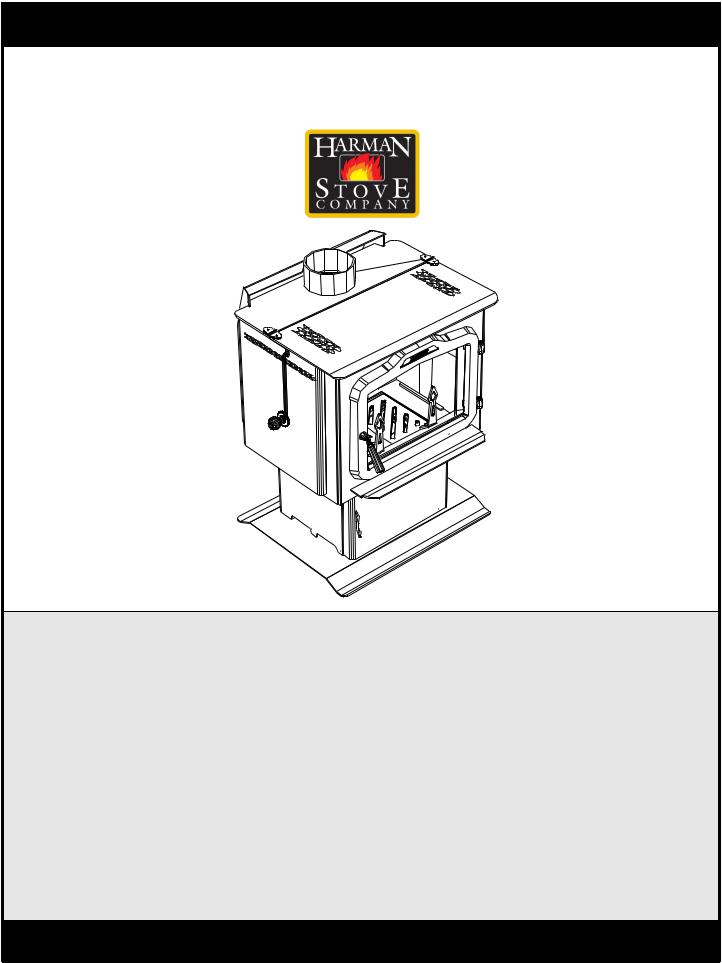
Installation & Operating Manual
The Harman Exception Wood Stove
(Model TL200)
R7
SAFETY NOTICE
PLEASE READ THIS ENTIRE MANUAL BEFORE YOU INSTALL AND USE YOUR NEW ROOM HEATER. FAILURE TO FOLLOW INSTRUCTIONS MAY RESULT IN PROPERTY DAMAGE, BODILY INJURY, OR EVEN DEATH.
FOR USE IN THE U.S. AND CANADA SUITABLE FOR INSTALLATION IN MOBILE HOMES
IF THIS HARMAN EXCEPTION MODEL TL200 STOVE IS NOT PROPERLY INSTALLED,AHOUSEFIREMAYRESULT. FOR YOURSAFETY, FOLLOW INSTALLATIONDIRECTIONS.
CONTACT LOCAL BUILDING OR FIRE OFFICIALS ABOUT RESTRICTIONSAND INSTALLATION INSPECTION REQUIREMENTS IN YOUR AREA.
CONTACT YOUR LOCAL AUTHORITY (SUCH AS MUNICIPAL BUILDING DEPARTMENT, FIRE DEPARTMENT, FIRE PREVENTION BUREAU, ETC.) TO DETERMINE THE NEED FOR A PERMIT.
CETTEGUIDE D'UTILISATIONEST DISPONIBLE EN FRANCAIS. CHEZ VOTRE CONCESSIONNAIRE DEHARMANSTOVE COMPANY.
SAVE THESE INSTRUCTIONS.

Exception TL200 Wood Stove
Introduction
Thank youfor purchasing the Harman Exception Wood Stove. With the Exceptionyou will notice evenheat throughout your home and long burn times. This is possible because of our exclusive Harman Afterburner Combustion System which takes unburned gases into the afterburner chamber where they are mixed with air and burned at very high temperatures.
The Harman Exception was designed to make burning wood easier by adding a top load door which allows more wood to fit into the large firebox. The Exception's smoke free designdraws smoke down throughthe stove, not into your room. The top load door also comes in handy when cooking on the optional cooking grill. Simply place the grill in the top load opening and grill great tasting meats and vegetables on the Harman Exception.
The Harman Exception exceeds safety standards. Warnock Hersey has tested and approved the Exceptionunder the following standards: UL 1482. CAN/ULC-S627, ANSI/UL 737 and EPA(Phase II). The Exception is also approved for use in mobile homes.
We strongly recommend this unit be installed by a Harman trained dealer. If you choose to install it yourself, please consult your Harmandealer for venting andpositioning advice.
Be aware of your local building codes, permits and insurance that may be required in your area.
This Harman Stove is covered by the Harman Gold Warranty, the best warranty offered in the hearth industry. Our warranty shows our confidence in the design and manufacturing of our stoves. See page 23 for warranty information.
The Harman TL200 meets the U.S. Environmental
Protection Agency’s emission limits for wood heaters sold after July 1, 1990.
SAFETY NOTICE: IF THIS HARMAN EXCEPTION MODEL TL200 WOOD STOVE IS NOT PROPERLY INSTALLED. AHOUSE FIRE MAY RESULT. FOR YOUR SAFETY, FOLLOW THE INSTALLATION DIRECTIONS CONTACT LOCALBUILDING OR FIRE OFFICIALS ABOUT RESTRICTIONSAND INSTALLATIONINSPECTIONREQUIREMENTS IN YOUR AREA.
Table of Contents
Specifications |
3 |
Operation |
5 |
Building a Fire |
7 |
Maintenance |
9 |
Installation |
11 |
Door Installation Tips |
13 |
Linkage Installation |
14 |
Chimney System |
17 |
Parts List |
21 |
Parts Diagram |
22 |
Warranty |
23 |
2
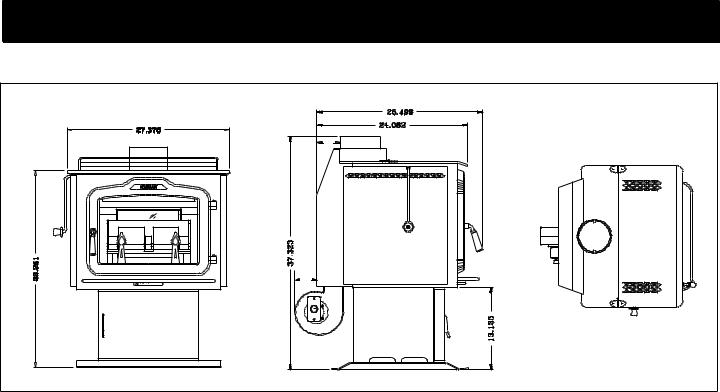
Exception TL200 Wood Stove
Specifications |
3.5" |
3.75" |
|
Weight |
440 lbs |
|
|
|
|
|
|
Flue Size |
6 inch |
|
|
|
|
|
|
Log Length Recommended |
18" with 20" Max |
|
|
|
|
|
|
Heating Capacity |
1500 to 2800 sq. ft. |
|
|
|
|
|
|
Average Emissions |
4.4 Grams Per Hr. |
|
|
|
|
|
|
Emissions on Low |
2.25 Grams Per Hr. |
|
|
|
|
|
|
Blower Size (optional) |
105 cfm variable speed |
|
|
|
|
|
|
Outside Air size |
3 inch |
|
|
|
|
|
3
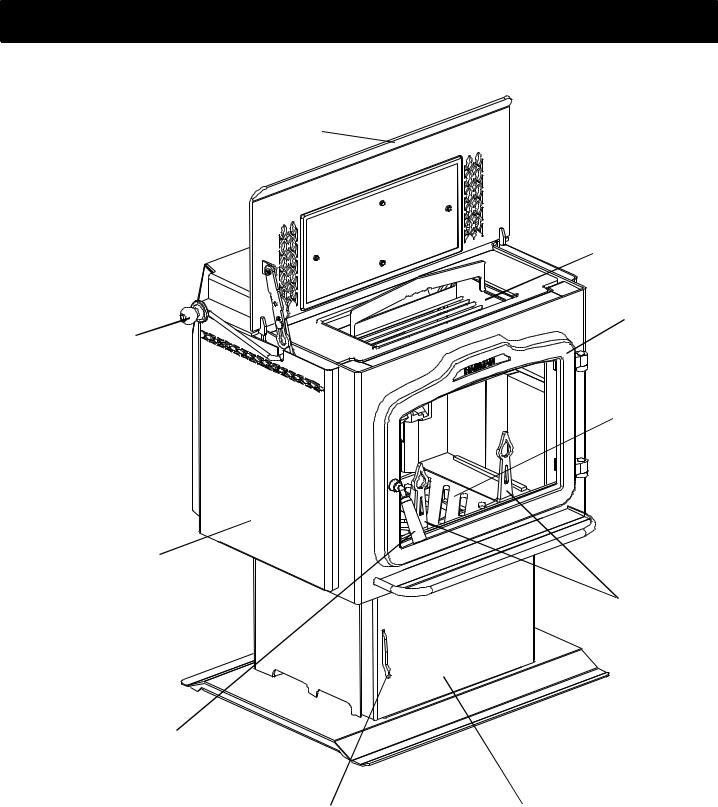
Exception TL200 Wood Stove
Specifications
Top Load Door
Top Load Opening
FrontLoad Door
Combination Top
Load Door and
Damper Arm
Grates
Side Shield
Andirons
Front Load
Door Latch
Ash Door Latch |
Ash Door |
|
4

Exception TL200 Wood Stove
Operation
General Considerations
Draft
Before you install and operate your Exception wood stove, please readthe entire contents of this manual. Pay particular attention to the explanation of draft and its effect on stove performance in the venting section. By following the installation and operating guidelines, you will ensure proper draft and gain maximumefficiency and enjoyment from your stove.
Fuel
Your Exceptionburns wood very efficiently. Here are some guidelines concerning firewood that willhelp you obtain the best performance.
Select hardwoods if possible, as they are heavier and containmore heatingcapacity (BTU’s) per load than
do softwoods. Wood should be split and stored under coverfor “seasoning”- ayear isrecommended. Your stove
is not an incinerator - do not burn garbage, painted or treated wood, plastic, or other debris.
Keepthe area around the stove free from clutter. Keep all combustibles, including fuel, beyond the coderequired clearance distance (48" or 1215 mm in the U.S., 1525 mmor 60" in Canada). Never store fuelin front of the stove where it couldinterfere withdoor operation, safe loading, and ash removal.
WARNINGS
•For use with solid wood fuel only.
•Do not burn garbage or flammable fluids such as gasoline, naptha, or engine oil.
•Do not burn any fuel other than wood, such as charcoal, which can cause increased carbon monoxide production or overfiring. Never use highly volatile substances in your stove, such as gasoline, which could cause an explosion.
The Stove
Doors
Your stove has a large glass-paneled door for loadingandfireviewing, aseparate smallerdoor forremovingashes and a top loading door. To open the glass door, turn the handle clockwise and pull out; to close the door, return the handle to an open(9 o'clock) position andpush into engage the latch while turning the handle counterclockwise to the closed (6 o'clock) position. To open the ash door, lift up the handle and pullout. Close the door by pushing inand pushing the handle all the way down. To open the top load door move the wooden knoblocated onthe left side of the stove front and upward until it locks the top open.
If the latch in either of your Exception doors needs adjustment, follow the instructions given inthe Maintenance section.
Alldoors must be closed while the stove is in normal operation, and the gaskets routinely examined for wear and replaced when necessary. The fuel door may be left open andthe opening covered witha screenwhen operating as a fireplace. Gooddoor seals are important for maintaining control of the stove. Operating the stove with the ash door open, or with a door inadequately sealed, could create a serious overfiring condition(discussed later in this section).
NEVER OPERATE WITHMORE THANONE DOOR OPEN AT A TIME
The glass used in your Exception is manufactured to exact standards to withstand the high heat of the fire, but like all glass, it must be treated with common sense and care. Never abuse the glass by slamming the door shut or striking the glass with a heavy object. If the glass is broken or damaged, do not operate the stove untilit has been replaced (See instructions in the Maintenance section.)
Grates
The Harman Exception’s unique grate systemconsists of two flat bottom grates, and two front andirons. The bottom grates have slots which allow the ash to fall into the ash pan by passinga poker back andforth across the grates. The andirons keep the fuel from coming in direct contact with the glass, and keep hot coals and embers from spilling out while reloading. Never build a fire directly against the glass.
Andiron extensions (included with each stove) clip onto the fixedandirons andserve to protect the glass when top loading is used as the primary loading method. The extensions can be clipped on the outside or inside of the andirons.
The grates and andirons must remain in place at all times. Do not tamper with or change the configuration of this grate system.
5
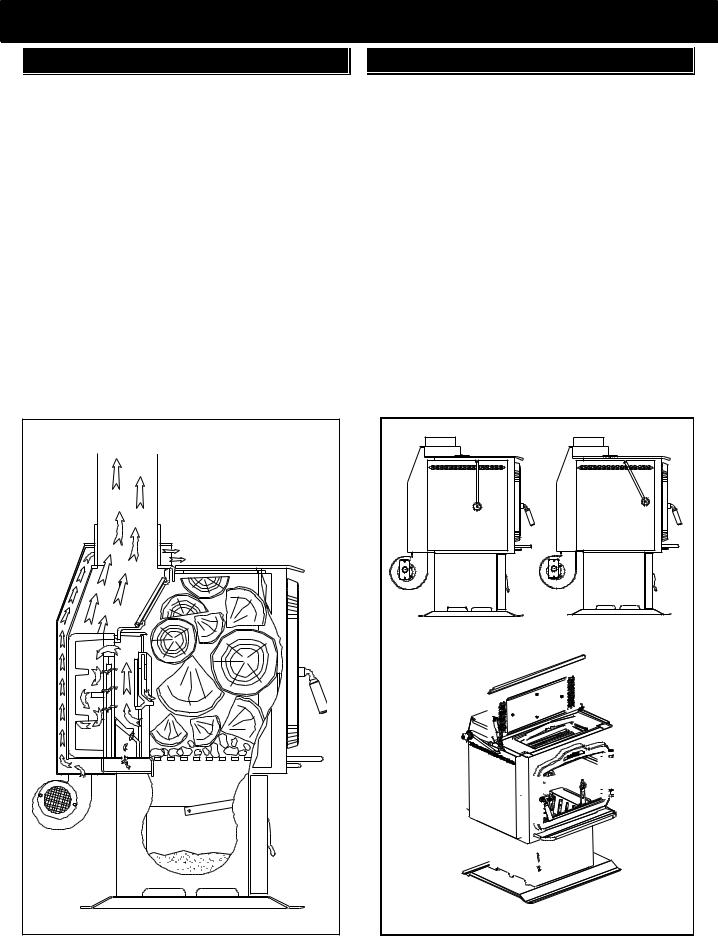
Exception TL200 Wood Stove
Operation
The Combustion Process |
Controls |
Combustionin your Harman Exceptionis controlled
very precisely. During a wood fire, primary combustion air enters the bottomof the stove, is directed up to the top of the load door and then down past the glass, finally entering the combustion chamber. Secondary combustion air enters the bottom of the stove and is delivered directly to the afterburner behind the firebox, where it provides the additional oxygen required for clean burning
During combustion, burning proceeds through severalstages - an initial evaporation stage, where mois-
ture is releasedfrom the wood; a stage where volatile gases containing much of the wood’s heating capacity are re-
leased and burned; and a charcoal stage, where the remainingcharcoal burns to release the additionalheat available. What is left after this final stage is ash. Within the firebox, two or more of these stages are generally occurring at once.
Two important controls - the top loading door handle and the air controllever regulate the operationand output of the stove.
Top loading door handle/damper interlock. The top loading door handle is linked to the bypass damper and serves two purposes. Move the handle forward one position (approximately 3") and the handle automatically opens the bypass damper. In this mode of operation the combustion gases go directly from the main combustion chamber to the flue collar and exit into the chimney.
Continue moving and lifting the handle and it opens the top loading door.
NOTE: The bypass damper must be open for smokeless loading. This is particularly important to remember whenloading woodthrough the front door since the front door andthe bypass damper are not interlockedin the same way that the top loading door is interlocked with the bypass damper. Open the bypass damper by moving the topdoorhandle forwardone positionbefore openingthe loading door.
Damper Closed |
|
|
|
|
|
|
|
|
|
|
|
Damper Open |
|||||||||||||||||||||||||
|
|
|
|
|
|
|
|
|
|
|
|
|
|
|
|
|
|
|
|
|
|
|
|
|
|
|
|
|
|
|
|
|
|
|
|
|
|
|
|
|
|
|
|
|
|
|
|
|
|
|
|
|
|
|
|
|
|
|
|
|
|
|
|
|
|
|
|
|
|
|
|
|
|
|
|
|
|
|
|
|
|
|
|
|
|
|
|
|
|
|
|
|
|
|
|
|
|
|
|
|
|
|
|
|
|
|
|
|
|
|
|
|
|
|
|
|
|
|
|
|
|
|
|
|
|
|
|
|
|
|
|
|
|
|
|
|
|
|
|
|
|
|
|
|
|
|
|
|
|
|
|
|
|
|
|
|
|
|
|
|
|
|
|
|
|
|
|
|
|
|
|
|
|
|
|
|
|
|
|
|
|
|
|
|
|
|
|
|
|
|
|
|
|
|
|
|
|
|
|
|
|
|
|
|
|
|
|
|
|
|
|
|
|
|
|
|
|
|
|
|
|
|
|
|
|
|
|
|
|
|
|
|
|
|
|
|
|
|
|
|
|
|
|
|
|
|
|
|
|
|
|
|
|
|
|
|
|
|
|
|
|
|
|
|
|
|
|
|
|
|
|
|
|
|
|
|
|
|
|
|
|
|
|
|
|
|
|
|
|
|
|
|
|
|
|
|
|
|
|
|
|
|
|
|
|
|
|
|
|
|
|
|
|
|
|
|
|
|
|
|
|
|
|
|
|
|
|
|
|
|
|
|
|
|
|
|
|
|
|
|
|
|
|
|
|
|
|
|
|
|
|
|
|
|
|
|
|
|
|
|
|
|
|
|
|
|
|
|
|
|
|
|
|
|
|
|
|
|
|
|
|
|
|
|
|
|
|
|
|
|
|
|
|
|
|
|
|
|
|
|
|
|
|
|
|
|
|
|
|
|
|
|
|
|
|
|
|
|
|
|
|
|
|
|
|
|
|
|
|
|
|
|
|
|
|
|
|
|
|
|
|
|
|
|
|
|
|
|
|
|
|
|
|
|
|
|
|
|
|
|
|
|
|
|
|
|
|
|
|
|
|
|
|
|
|
|
|
|
|
|
|
|
|
|
|
|
|
|
|
|
|
|
|
|
|
|
|
|
|
|
|
|
|
|
|
|
|
|
|
|
|
|
|
|
|
|
|
|
|
|
|
|
|
|
|
|
|
|
|
|
|
|
|
|
|
|
|
|
|
|
|
|
|
|
|
|
|
|
|
|
|
|
|
|
|
|
|
|
|
|
|
|
|
|
|
|
|
|
|
|
|
|
|
|
|
|
|
|
|
|
|
|
|
|
|
|
|
|
|
|
|
|
|
|
|
|
|
|
|
|
|
|
|
|
|
|
|
|
|
|
|
|
|
|
|
|
|
|
|
|
|
|
|
|
|
|
|
|
|
|
|
|
|
|
|
|
|
|
|
|
|
|
|
|
|
Top Load Door Open and Locked
6
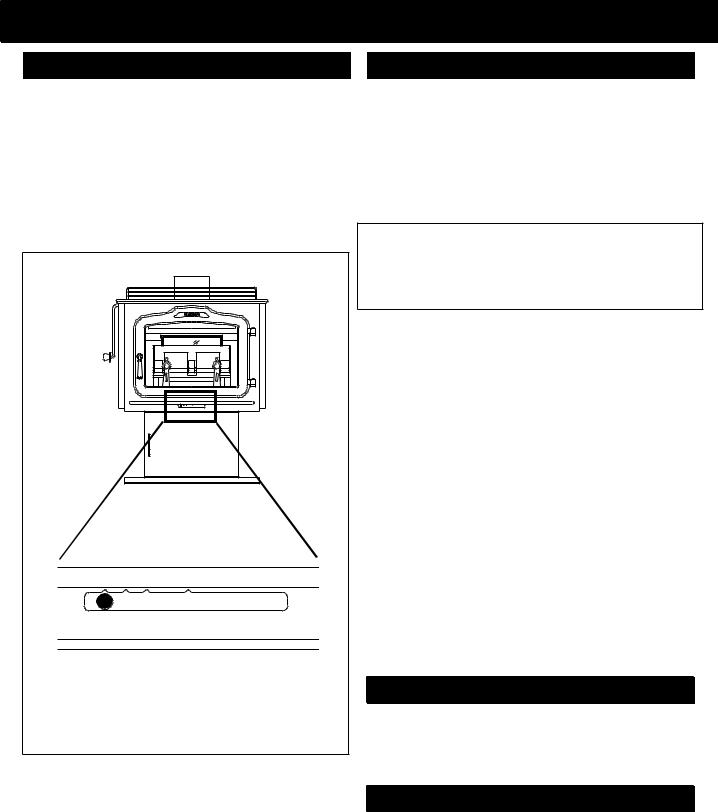
Exception TL200 Wood Stove
Operation
Air Control |
|
Building and Maintaining the Fire |
|
|
|
The air control lever is located directly below the ash lip of the stove. Using this lever youwill be able to vary the amount of air delivered to the fire, creatinga range of heat outputs. The low heat output setting is to the left, and high is to the far right. Do not, under any circumstances, alter the configuration or operation of the air control lever.
Less |
More |
Below this setting, run the optional blower on "low" or "OFF". Higher air movement cools the secondary combustionarea which can leadto poor combustion and lower efficiency.
The Harman Exception was testedwith the fuel door open and closed. If you operate under normal conditions keepdoor closed.
Set the air controllever at the maximum heat output setting, all the way to the right. Open the bypass damper by movingthe top loading handle forward one position (approximately 3"). The convectionblower, if installed, should be off for the first five minutes after a reload.
Never use gasoline, gasoline-type lantern fuel,
kerosene, charcoal lighter fluid, or similar liquids to start or “freshen up” a fire in this heater. Keep all
such liquids well away from the heater while it is in use.
Build a bed of paper and kindling; place several 1 " - 2" (25 mm - 50 mm) split pieces of dry wood on top, followed by a few 2" - 3" (50 mm - 80 mm) split pieces. Ignite the paper a nd close the door.
Allow the fire to burn until a good charcoal bed, 2" - 3" (50 mm - 80 mm) is formed; close the bypass damper by pushing the top loading handle all the way back until it locks closed. (You may needto leave the load door open a crack to get the blaze going properly, but never leave the stove unattended withdoor open.) Addmore woodto create a deeper charcoal base (3" - 4", or 80 mm - 100 mm thick); remember to open the bypass damper if you are loading fromthe front. This will allow the exhaust gases to pass directly into the flue outlet and reduce smoke spillage during refueling.
Once the charcoal bed is established you may add a full load of dry wood. After adding the fuel, leave the damper open and the air setting at maximum for 5 to 15 minutes; close the damper and allow the air setting to remain on high for an additional 5 to 10 minutes. Then adjust the air lever and blower speed for the desired heat output.
Reloading
Once you have prepared andmaintained a thick charcoal bed, you should be able to reload the stove, allow some open damper burning at the maximum air setting, close the damper and reset the air control in about five minutes.
Blower
To regulate the speed of the optional convection blower, adjust the control from low to high by turning the knob located on the blower. The blower speed should be matched to the air control lever setting.
When the air setting is low, the blower should always be at the minimum setting(corresponding to a blower speed of 750 RPM.) At higher settings, above first notch on the air control, the blower may be set to your desired comfort level. Be sure that the blower cord does not run
under, over, above or infront of the stove. |
7 |
